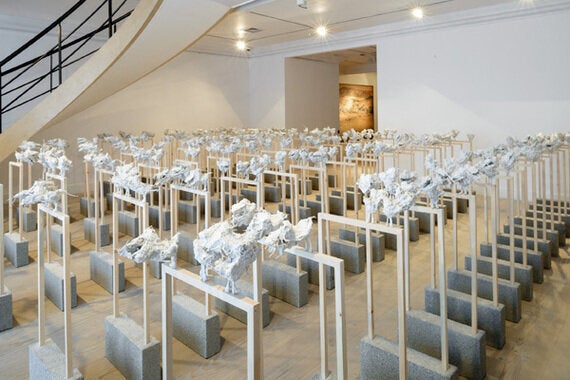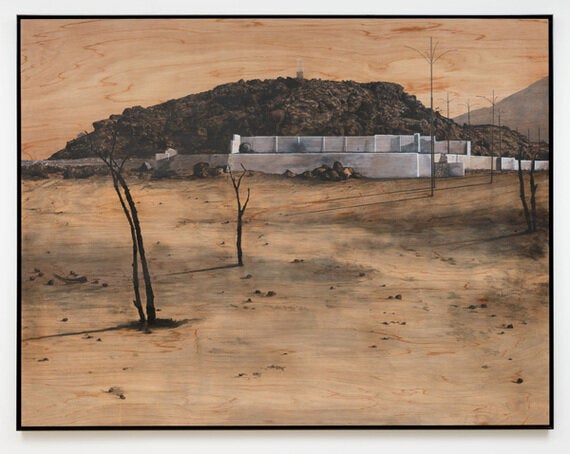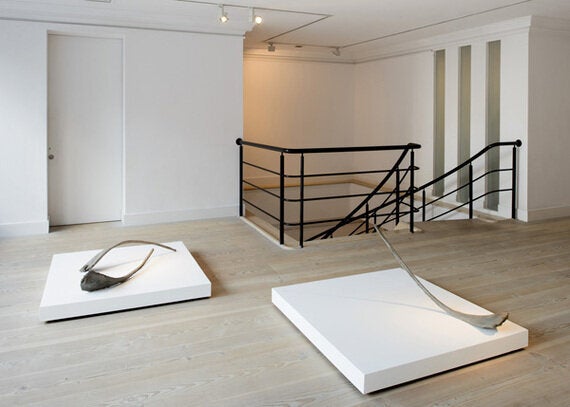Earlier this year, while on a guided tour of the Grand Mosque in Mecca, Oxford-based artist Saad Qureshi noticed a number of beautiful and melodious birds flying around the building.
The guide referred to a fable in the Koran in which abaabil birds (Arabic for flock) are described as the soldiers of Allah, defeating the forces of evil which were attacking the Ka'bah, Islam's most sacred shrine, by dropping hot pebbles on its opposing army.
"As soon as I heard this story, these birds transformed before my very eyes," he explains as we walk around his installation. "I thought these are not just any birds, these are special birds. I'm referring to the power of knowledge. I didn't know these birds but as soon as I had this piece of information planted in my head, it took on a whole new meaning for me."
Exploring the power of knowledge - how and why things take on an importance beyond their physical presence - is the main theme of Congregation, Qureshi's new exhibition at London's Gazelli Art House.
Qureshi lived most of the first nine years of his life in Pakistan before moving to the UK. He still maintains close links with his former homeland and strives to nurture his twin identities.
After graduating from the Slade School of Fine Art in 2010, he has exhibited widely both in the UK and abroad including in New York, Hong Kong, Turin, Rome and Istanbul.
Subsequent research revealed that Koranic scholars had further developed the fable of the abaabil birds, mythologising them into the largest birds ever seen, with green, predatory faces and paws like dogs'.

In the eponymous Congregation (above) Qureshi has reinterpreted the myth by sculpting 313 bird-like creatures standing on 99 concrete plinths, arranged in the ranks of an army. The numbers are hugely significant to him but revealing the nature of this, he says, would obstruct the viewer's own interpretation.
The creatures are made from plaster, clay and straw to give them a fossilised effect - frozen in time. You can almost hear their cacophony.
"I wanted to construct a combination of the real and the imagined. It was really important that the birds were seen as the birds of the mind, as much as the physical matter."
This is not religious art. Such birds are seen in many religions and cultures - the dragon, griffin, phoenix and so on. Qureshi is interested in what he calls the relationship between matter and aura, the power of belief and applied knowledge.

This combination of real and imagined is continued in the exhibition's large landscapes. Typical is The Final Aggregation (above), drawn in Indian ink, charcoal and chalk on gaboon marine plywood.
The sepia colour sets the tone - barren and empty. The rich grain of the wood becomes part of the scene itself. A heap of indeterminate material is seemingly held back by a dam of a wall. While in both the fore and background, dead trees and pole-like structures inhabit the picture. It's a recurring Qureshi motif, deliberately ambiguous..
There are religious references here but Qureshi is transforming the religious into the secular. Ironically, he says, the art gallery and the museum in our secular society has displaced the church, mosque, temple and so on, as the main places for reflection.

Interspersed among the landscapes are sculptures in the form of date palm leaves such as in Dead Leaves Lie Still 1 and 2 (above). The leaves are cast in concrete. Palm leaves have significance in many religions, yet once again their ambiguity serves as a discussion point, and another example of how matter and aura inter-relate.
Congregation is showing at the Gazelli Art House, 39 Dover Street, London W1S 4NN until 23 November.
All images are used with the permission of photographer Sam Drake, the artist and the gallery.